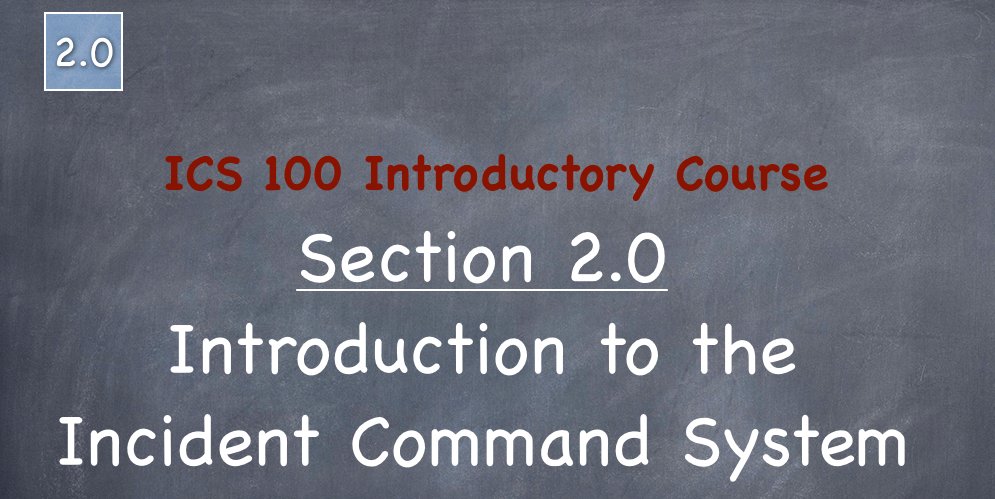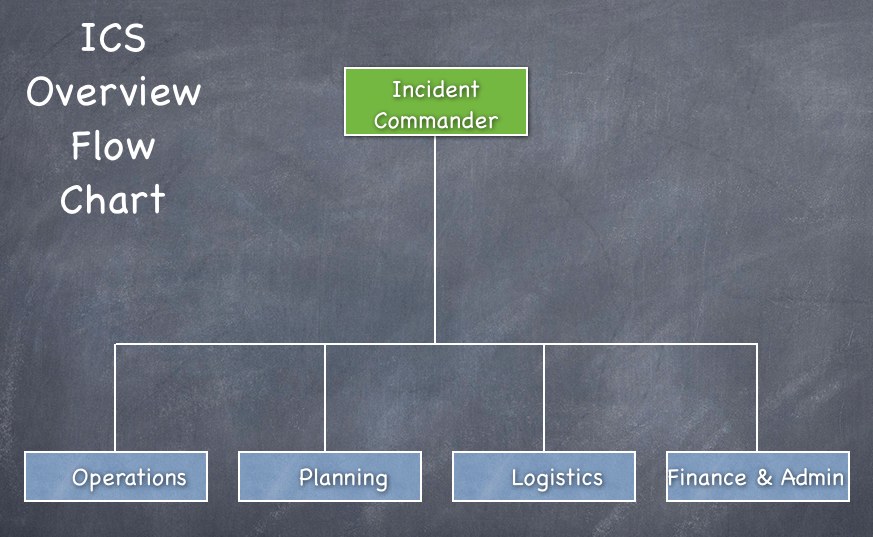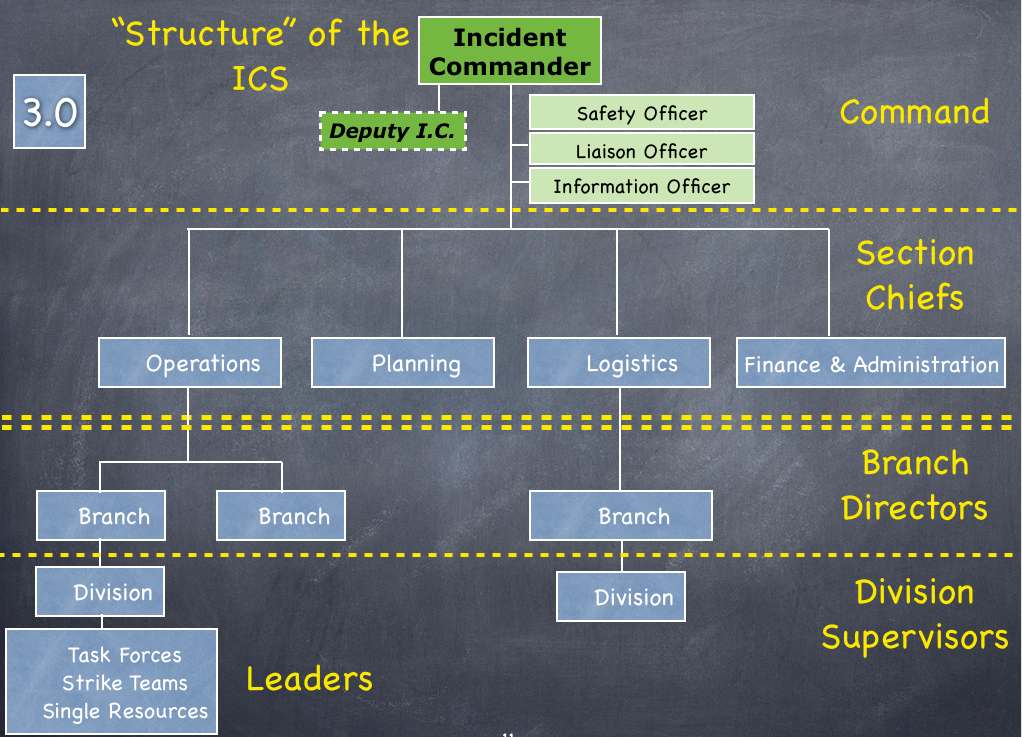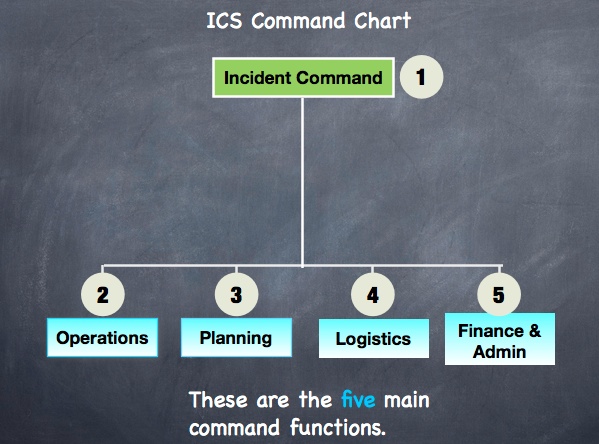DO NOT COPY - ALL contents - Copyright Protected
DRAM Ventures Inc. / www.firesafetraining.com

ICS 100 Introduction Course - Outline
1.0 Course Overview & Objectives
2.0 Introduction to the Incident Command (management) System
3.0 Main Components of ICS
4.0 IC Roles and Command Functions
5.0 General Section Staff Functions
6.0 ICS Facilities and Identification
7.0 Common Responsibilities
8.0 Short Quiz
Key Points for all Incidents
- THE SITUATION MUST BE EVALUATED BEFORE ANY RESPONSE
- RESOURCES MUST BE MANAGED IN A SAFE AND EFFICIENT MANNER
- PERSONNEL AND EQUIPMENT MUST NOT RESPOND UNLESS FORMALLY DISPATCHED
Any task requires that it be carried out in a;
- safe
- efficient
- cost effective manner
This is true with non-emergency situations or emergency incidents.
The Incident Command System addresses all of these points.
An incident or event organizational system must have;
- structure
- flexibility
- ability to increase or decrease the management organization
The Incident Command System has all the above features
The points above are very critical features for any emergency management system.
ICS provides for UNITY OF COMMAND
Every person reports to only one supervisor
Below: A typical ICS management chart for a small incident - or the first few hours of what may develop into a much larger incident.

If it helps you to get a clearer "picture" of this chart, think of the "boxes" as being "functions" or duties. A defined group of tasks that must be done as part of the whole.
... And keep in mind that an Incident Management Team may consist of less than five people because a person may be responsible for more than one “function”. (For example, one person could be the I.C., and also fill one or more of the other “functions”). This could apply with a small incident and a small response team. (Maybe three persons in total)
Below: the incident management structure has now "expanded" to accommodate the requirements of a larger incident.
(This will be discussed further in Section 3.0)

… the Past ...
The usual emergency response agencies,
- police
- fire
- ambulance
Each did "their own thing" when responding to an emergency incident. A UNIFIED response was seldom a formal, planned action.
Pre-planning with each agency was not common.
Budgets often came from different sources and the purchasing officers would not be communicating with other organizations outside of their own. Therefore, many common denominators were overlooked. Some of these were;
- common training needs
- common equipment needs
- common communication systems
- common terminology
- who is accountable / responsible for what
- no formal objectives set
- no formal incident management structure
- assumptions made
- no task designation or overlapping designation
The primary goal in dealing with the emergency may also have been quite different for each responding agency.
An example of this could be if a forest fire crew responded to a brush fire where there was a house already burning, the crew would focus on the forest.
If a structural fire crew (Volunteer Fire Department) arrived, they would focus on the home.
If the police arrived they may focus on crowd or traffic control.
Possibly no one was coordinating all current actions and future common needs. It is possible that no one was considering the livestock evacuation needs. Who is taking care of the electrical power concerns? ... and on it may go ...
Possibly no one was considering where do the people evacuate to and who looks after them?
... and how are all the different agencies communicating with each other??
With limited human power and resources, an overlap, or gaps in the needs of dealing with the incident may occur - often with costly or tragic results.
All of the different agencies usually had no plan or method in place to integrate each others' requirements or supportive capabilities.
Example: Structural fire departments - many of whom are smaller, rural departments - connect their fire hoses with threaded fittings.
Many forest fire fighting agencies have a different type of connection called an "instant coupler".
Instant coupler and threaded fittings will NEVER connect. (it will not matter how many rolls of duct tape you may have!)
Interagency Cross-Training
More recently there has been a lot of interagency cross-training between forest fire agencies and fire departments and now it will be safe to say that close to 100% of the fire departments carry connection adapters so instant couplers and threaded fittings can be connected. This one change is huge when mutual fire fighting aid is being offered.
… the Past … In Summary
- poor communication
- terminology
- no interagency training
- poor planning
- inefficient resource use
- gaps in responsibility and accountiblity
- equipment compatibility
Critical Point in History
1970 - California - Huge losses
- 16 lives
- 700 structures burned
- half a million acres burned
- $18 million dollars per day
... and now adding to the above issues - there is far more cross state / county / province and even country mutual aid being given.
Solutions
Governments
and individuals realized something had to be done. Each agency did
their very best but the issues as noted above had to be dealt with and
changed. Several agencies in the U.S.A. collaborated on all the many concerns in an attempt to make changes to improve overall emergency response actions. These changes did not occur
overnight but a system was created that seemed to work - and is still
working today - over forty years later.
Incident Command System (ICS)
DO NOT COPY - ALL contents - Copyright Protected
DRAM Ventures Inc. / www.firesafetraining.com

Every incident shall have the above five functions.
The Incident Commander in the above diagram, has four positions or functions subordinate to him/her. Therefore the Span-of-Control is four. (we will discuss Span-of-Control in more detail later)
Standardizing the command system structure and terminology;
- allows for a more safe and effective use of resources
- personnel are trained to "speak" and understand the same phraseology
- provides for more effective communications
- everyone understands the ICS protocol with the system
All the above points are especially important in situations where there are different languages, cultural and mulit-jusitictional circumstances.
DO NOT COPY - ALL contents - Copyright Protected
DRAM Ventures Inc. / www.firesafetraining.com
DO NOT COPY - ALL contents - Copyright Protected
DRAM Ventures Inc. / www.firesafetraining.com
Every Formal Incident Will Have;
Incident Commander
Operational Unit/ function
Logistics Unit / function
Planning Unit / function
Finance & Administration Unit / function
We wish to acknowledge and thank all organizations and persons for the use of all videos and photos on this web site.
